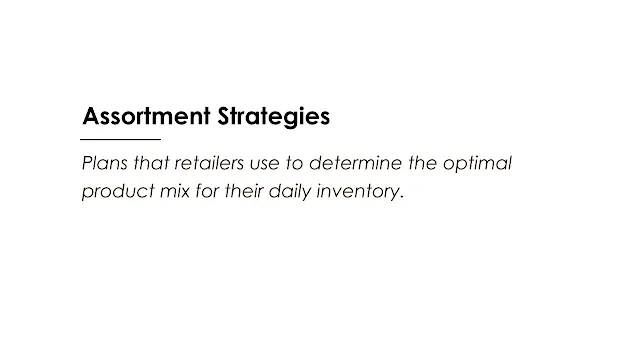 |
| Image: Moneybestpal.com |
Assortment strategies are plans that retailers use to determine the optimal product mix for their daily inventory. Since customers immediately engage with the product mix on display and base their purchase decisions on what they see, they are crucial to the retail industry.
Assortment strategies are defined according to two main factors: product width and product depth. Product width refers to the range of product lines that a retailer offers. An example would be a supermarket that sells everything from food to cosmetics to over-the-counter medical products. The variety of goods offered within each product line is referred to as product depth. For instance, the store in issue is probably going to have hundreds of different cereal alternatives if it's a specialty cereal shop.
Wide, deep, and scrambled are the three basic varieties of assortment strategies. When shops want to offer a variety of product lines or categories, but with less depth in each, they employ a wide assortment strategy. Although it does not offer a large number of products in each product line, it attempts to offer a greater variety in the product lines that are offered. An example of a business using a wide assortment strategy is a grocery store that sells a variety of goods but only carries one or two brands of each kind of good.
The goal of a deep assortment strategy is to offer a lot of options for a certain product category. Specialty stores that specialize in one or a few products frequently employ a deep assortment strategy. For instance, a supplement store that focuses on fewer product lines but with great depth and variety within each product line is likely to provide customers looking for protein powders with a wide range of possibilities.
A scrambled assortment strategy is used when retailers offer products that are not related to each other or to their core business. It is frequently utilized to gain a competitive edge, promote impulse purchases, and draw in new clients. Scrambled assortment is employed, for instance, by a bookstore that also offers coffee and snacks.
The benefits of using assortment strategies include:
- By providing a variety of products that meet various tastes, budgets, and occasions, you may satisfy customer preferences and needs.
- Giving customers a pleasurable shopping experience and promoting repeat business will increase consumer loyalty and retention.
- Enhancing brand reputation and image by developing a unique identity and market positioning.
- Enhancing cross-selling and up-selling opportunities while minimizing stockouts and maximizing inventory turnover to increase sales and profits.
The challenges of using assortment strategies include:
- Finding the ideal level of product width and depth that satisfies consumer expectations without overstocking or understocking can help you balance customer demand and inventory costs.
- Sourcing, distributing, and replacing goods from numerous vendors and locations in order to manage the complexity and coordination of the supply chain.
- Modifying the product mix in response to trends, customer input, and performance statistics in order to adapt to shifting market conditions and consumer preferences.
- Offering distinctive and valued products that stand out from the competition might help you stand out from the competition.
